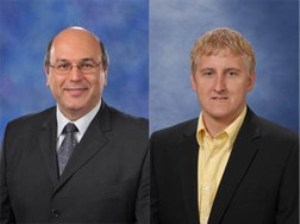Nov 3 2012
A recent research article cowritten by Dr. Dimitris Lagoudas (pictured left) and Dr. Darren Hartl from the Department of Aerospace Engineering was recently featured as the cover article in the journal Smart Materials and Structures, which is the leading journal for the active materials and adaptive structures community.
 Photo of Dr. Lagoudas and Dr. Hartl
Photo of Dr. Lagoudas and Dr. Hartl
Lagoudas holds the John and Bea Slattery Chair in Aerospace Engineering, and is the senior sssociate dean for research
in the Dwight Look College of Engineering; the deputy director of the Texas A&M Engineering Experiment Station (TEES); and associate vice chancellor for engineering research of The Texas A&M University System. Hartl is a TEES assistant research professor with the department. Together they lead the Texas Institute for Intelligent Materials and Structures (TiiMs), a TEES research center.
Lagoudas has been working in the area of smart material modeling and analysis for the past 20 years and has been working with Hartl since 2002. Their research team continues to develop new and enhanced methods for addressing the behavior of smart and multifunctional materials at the nano-, micro-, and macro-scales, including implementation into aerospace applications.
Stephen Oehler, a recent master's graduate and current structures analyst for Boeing Research and Technology, was lead author. The paper, which demonstrates a new framework for the optimized design of morphing structures, also includes contributions from Dr. Richard Malak of the Department of Mechanical Engineering.
This work represents the initiation of a new collaborative effort between the two departments related to the design of morphing aerostructures. The paper highlighted specifically considers the design of morphing chevrons for installation in jet engine exhaust flows for the purposes of selectively mixing fluid streams and reducing aircraft noise.
The journal "is dedicated to technical advances in smart materials, systems and structures, including materials, sensing and actuation, optics and electromagnetics, structures, control and information processing."